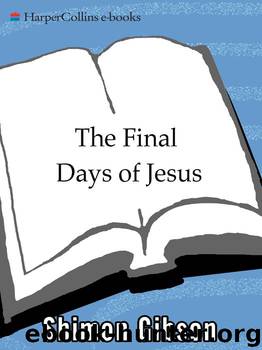The Final Days of Jesus: The Archaeological Evidence by Shimon Gibson

Author:Shimon Gibson [Gibson, Shimon]
Language: eng
Format: mobi
Publisher: HarperCollins
Published: 2009-02-20T05:00:00+00:00
Figure 10: Map of the rocky areas and cavities underlying the Church of the Holy Sepulchre
(drawing: Shimon Gibson; adapted from Gibson/Taylor 1994).
The sheer rock-cut scarps left by the quarrymen were ideal for burial caves to be cut into them. Eventually, the lower quarried areas were abandoned and filled in with soil and quarry debris, with some abandoned quarry areas being converted into garden patches and orchards. Hence, we should reconstruct this area at the time of Jesus as a large rocky knoll with an expanse of rock-hewn cavities and subterranean indentations at many different levels.215 The size of this locality appears to have spanned at least 200 meters from north to south and 150 meters from east to west. The depressions in the ground, especially where the quarrying activities had ceased, were partly used for horticulture or arboriculture. Some of the rocky scarps were pierced with openings leading to burial caves. This combination of burial caves, stone quarrying, and agricultural activities at the same spot was a common phenomenon in the first century CE as we can learn from archaeological finds in the city’s surroundings.
This rocky area should in my opinion be identified as Golgotha.216 It was here, not far from the road extending along the Transversal Valley (from the direction of the Praetorium) and close to the Gennath Gate, that the execution grounds would have been situated. If we accept the testimony of John, Jesus was also buried in the vicinity. We may surmise that the exact situation of Golgotha was passed down from generation to generation among Jesus’s supporters, even when the place itself came to be hidden beneath the pavement of the Forum and Temple of Venus in Aelia Capitolina, which was built after 135 CE to replace the ruins of Jerusalem. This is clear from Eusebius, an erudite and learned scholar writing in the late third century, who noted that the “Place of the Skull” was still “pointed out in Aelia” on the northern side of Mount Zion, indicating that knowledge of the whereabouts of Golgotha had been maintained from 70 CE and until his day. Present-day visitors to the Church of the Holy Sepulchre are shown the Rock of Calvary and told that this is where the crucifixion took place. I have already shown that to place a crucifixion on the top of this narrow mass of rock would not have been feasible. The rock is therefore a finger-like “marker” representing the general place of the crucifixion, but nothing more. Instead, Christian writers and travelers from the fourth century CE onward, such as the Bordeaux Pilgrim, Cyril of Jerusalem, and Egeria, make it clear that they understand Golgotha to be a very large expanse of rock spread beneath the large basilica, or the “Martyrium,” built at the instigation of Constantine the Great to the east of the Tomb of Jesus. The actual place where a patch of the rock of Golgotha was shown to visitors and venerated was probably located at the west end of the building within the area of its domed apse.
Download
This site does not store any files on its server. We only index and link to content provided by other sites. Please contact the content providers to delete copyright contents if any and email us, we'll remove relevant links or contents immediately.
The Gnostic Gospels by Pagels Elaine(2399)
Jesus by Paul Johnson(2229)
Devil, The by Almond Philip C(2205)
The Nativity by Geza Vermes(2115)
The Psychedelic Gospels: The Secret History of Hallucinogens in Christianity by Jerry B. Brown(2073)
Forensics by Val McDermid(1979)
Going Clear: Scientology, Hollywood, and the Prison of Belief by Lawrence Wright(1884)
Going Clear by Lawrence Wright(1873)
Barking to the Choir by Gregory Boyle(1729)
Old Testament History by John H. Sailhamer(1713)
Augustine: Conversions to Confessions by Robin Lane Fox(1686)
The Early Centuries - Byzantium 01 by John Julius Norwich(1654)
A History of the Franks by Gregory of Tours(1637)
The Bible Doesn't Say That by Dr. Joel M. Hoffman(1608)
Dark Mysteries of the Vatican by H. Paul Jeffers(1606)
A Prophet with Honor by William C. Martin(1603)
by Christianity & Islam(1561)
The First Crusade by Thomas Asbridge(1539)
The Amish by Steven M. Nolt(1489)
